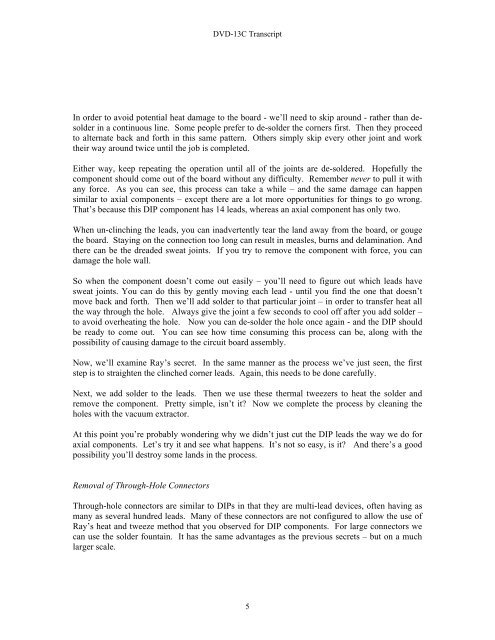You also want an ePaper? Increase the reach of your titles
YUMPU automatically turns print PDFs into web optimized ePapers that Google loves.
DVD-13C <strong>Transcript</strong>In order to avoid potential heat damage to the board - we’ll need to skip around - rather than desolderin a continuous line. Some people prefer to de-solder the corners first. Then they proceedto alternate back and forth in this same pattern. Others simply skip every other joint and worktheir way around twice until the job is completed.Either way, keep repeating the operation until all of the joints are de-soldered. Hopefully thecomponent should come out of the board without any difficulty. Remember never to pull it withany force. As you can see, this process can take a while – and the same damage can happensimilar to axial components – except there are a lot more opportunities for things to go wrong.That’s because this DIP component has 14 leads, whereas an axial component has only two.When un-clinching the leads, you can inadvertently tear the land away from the board, or gougethe board. Staying on the connection too long can result in measles, burns and delamination. Andthere can be the dreaded sweat joints. If you try to remove the component with force, you candamage the hole wall.So when the component doesn’t come out easily – you’ll need to figure out which leads havesweat joints. You can do this by gently moving each lead - until you find the one that doesn’tmove back and forth. Then we’ll add solder to that particular joint – in order to transfer heat allthe way through the hole. Always give the joint a few seconds to cool off after you add solder –to avoid overheating the hole. Now you can de-solder the hole once again - and the DIP shouldbe ready to come out. You can see how time consuming this process can be, along with thepossibility of causing damage to the circuit board assembly.Now, we’ll examine Ray’s secret. In the same manner as the process we’ve just seen, the firststep is to straighten the clinched corner leads. Again, this needs to be done carefully.Next, we add solder to the leads. Then we use these thermal tweezers to heat the solder andremove the component. Pretty simple, isn’t it? Now we complete the process by cleaning theholes with the vacuum extractor.At this point you’re probably wondering why we didn’t just cut the DIP leads the way we do foraxial components. Let’s try it and see what happens. It’s not so easy, is it? And there’s a goodpossibility you’ll destroy some lands in the process.Removal of Through-Hole ConnectorsThrough-hole connectors are similar to DIPs in that they are multi-lead devices, often having asmany as several hundred leads. Many of these connectors are not configured to allow the use ofRay’s heat and tweeze method that you observed for DIP components. For large connectors wecan use the solder fountain. It has the same advantages as the previous secrets – but on a muchlarger scale.5
















